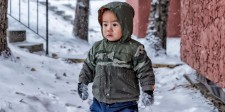Frostbite
What is frostbite?
In cold temperatures, skin that isn’t properly covered or
protected can freeze quickly. When skin freezes it’s called frostbite. The most
common body parts to get frostbite are the cheeks, ears, nose, fingers, and
toes.
- Skin will first become red and swollen and will feel like it is stinging or burning.
- If the skin isn’t protected or warmed, it will start to feel like it’s tingling and will look grey.
- If the skin freezes, the area will have no feeling and will be shiny and white.
Frostbite can happen in cold wind, rain, or snow. Once a part of the body has had frostbite, it’s more likely to happen again.
What is frostnip?
Frostnip is less severe than frostbite. It usually affects the same areas as above, leaving them red and numb or tingly. Frostnip can be treated at home and gets better with rewarming (see instructions below).
How can I protect my child from frostbite?
- Consider keeping them indoors whenever the temperature or the wind chill is reported to be -27°C (-16°F) or lower. At this temperature, exposed skin begins to freeze. If you care for a group of kids, it might be hard to ensure they are all safe from frostbite at these low temperatures.
- Plan to reduce the amount of time children spend outside when the temperature falls to -15°C (5°F) or colder, with or without wind chill.
- Babies and toddlers are more at risk of frostbite since they don't move as much and can't tell us when they are cold.
- If you’re a school or daycare provider, know and follow provincial/territorial child care regulations for your jurisdiction if they differ from these recommendations.
- Staff should use their judgment to decide whether to send students outside for recess. The socio-economic environment and the level of intensity of the activities should be taken into consideration.
- Never send children outside unsupervised in extreme conditions, such as a snowstorm.
- Dress your child in layers of clothing that can be put on and taken off easily. Make sure as much skin as possible is covered in cold temperatures.
- Children should wear a neck warmer and a warm hat that covers the ears. Most body heat is lost through the head, and ears can be easily frostbitten.
- Mittens are better than gloves in really cold temperatures because your child can bunch their fingers together inside the mittens to help keep them warmer.
- Provide warm, waterproof boots that are roomy enough for an extra pair of socks and to wiggle toes.
How do I treat frostbite?
If your child comes in from outside complaining that their fingers, toes or other body parts are sore, here’s what to do:
- Gently remove any clothing covering the area.
- Put your child in dry, warm clothing.
- Slowly warm up the area by gently covering it with your hand.
- Use warm (not hot) water to slowly warm affected body parts.
- If your child’s fingers are frostbitten, place them in their opposite armpit to warm.
- Do not massage or rub frostbitten skin.
- Seek medical advice immediately if your child’s skin is white, waxy or feels numb.
Reviewed by the following CPS committees
- Public Education Advisory Committee
Last updated: February 2023

